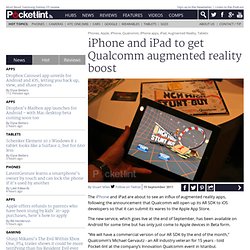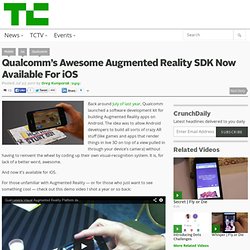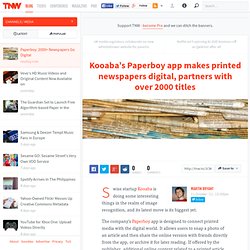

Optricks, developers of engaging apps. Player. Barclaycard and Orange plot NFC Christmas. Barclaycard has let slip plans to deploy NFC-enabled mobile phones, along with Orange, before the end of 2010. The details were spotted by NFC World, which reported on a presentation given by Barclaycard's Head of Innovation Marketing, Sarah Mansfield, during which she stated that by the end of 2010 Orange customers will be able to buy an NFC-enabled handset, and use an augmented-reality application to locate stores that accept NFC payments. NFC, or Near Field Communications, is used for payment systems that rely on the user waving the card near to a reader. Transactions below fifteen quid are approved without a PIN (though a PIN is occasionally requested at random), and the system is already embedded in millions of plastic cards from Barclaycard.
Putting the same functionality into a mobile phone should add features, such as transaction checking and pre-paid topping up, but the lack of an obvious revenue stream and customer indifference have prevented that happening. Mobile Augmented Reality Opportunities, Forecasts & Strategic Analysis 2011-2015. Junaio Brings Augmented Reality Superbowl Fun. iPhone and iPad to get Qualcomm augmented reality boost. The iPhone and iPad are about to see an influx of augmented reality apps, following the announcement that Qualcomm will open up its AR SDK to iOS developers so that it can submit its wares to the Apple App Store.

The new service, which goes live at the end of September, has been available on Android for some time but has only just come to Apple devices in Beta form. "We will have a commercial version of our AR SDK by the end of the month," Qualcomm’s Michael Gervautz - an AR industry veteran for 15 years - told Pocket-lint at the company’s Innovation Qualcomm event in Istanbul.
After a popular response from developers, Gervautz said that Qualcomm is taking its software formal, thereby allowing the 2,000 Apple developers already signed up to submit their apps and make money. At the moment, while developers can download the tools and mess around with the possibilities, they haven’t been able to actually submit them to the App Store to generate revenue. Qualcomm’s Awesome Augmented Reality SDK Now Available For iOS. Back around July of last year, Qualcomm launched a software development kit for building Augmented Reality apps on Android.

The idea was to allow Android developers to build all sorts of crazy AR stuff (like games and apps that render things in live 3D on top of a view pulled in through your device’s camera) without having to reinvent the wheel by coding up their own visual-recognition system. New Kinect App Adds Arm Wiggles to Bill Pay. Ever since Microsoft officially released its software developer kit to enterprising programmers worldwide, we've seen everything from jiggle-augmented breasts to sword fighting robots.
Now, thanks to Etronika, a Lithuania-based technology firm, we can forget about that shamefully dull history and prepare to take our Kinect experience to the with ... (admittedly not the actual final title of the software) is an app that will hypothetically be available on the Xbox Live dashboard of whomsoever is fortunate enough to bank with the company that plucks this sort of useless intriguing little gem from Etronika. Based on the simplistic actions of the plucky young girl we see in the demo video, it looks like users will be able to breeze through bill pay, credit card statements, and overdraft fees with just the flick of their wrist (or their hips, elbows, and both of their shoulders).
Kooaba Paperboy makes printed newspapers digital, partners with over 2000 titles. 11 October '11, 12:00pm Follow Swiss startup Kooaba is doing some interesting things in the realm of image recognition, and its latest move is its biggest yet.

The company’s Paperboy app is designed to connect printed media with the digital world. It allows users to snap a photo of an article and then share the online version with friends directly from the app, or archive it for later reading. If offered by the publisher, additional online content related to a printed article, such as videos or image galleries, can be accessed through the app. Deja Vu - your visual memory. What is kooaba Déjà Vu? Déjà Vu is an application which turns your iPhone into your visual memory. Use it to take pictures of things you want to remember. Each picture you take is a visual memo. The app integrates image recognition for automatic labeling of your snapshots whenever possible. Alternatively you can also label and tag your visual memos. The iPhone app is complemented with a web app, which allow the same features for adding, organizing, and searching your visual memos as on the iPhone.
Videos about kooaba Déjà Vu Key features A better mobile camera app. ZipPay To Launch New Mobile Payments Service Cheaper Than Square. The easiest way to describe stealthy mobile payments startup ZipPay is to say it’s like Square and Venmo had a baby, and this was the result.

Like Square, the startup aims to address the needs of individuals and small business owners who can’t afford the high fees associated with having their own merchant accounts by allowing them to accept credit card payments using their phone. Your Destination for Computer Vision. Your Destination for Computer Vision. Apple acquires Polar Rose face recognition startup. Polar Rose: photo tagging using face recognition, Flickr, and Facebook. Google vs. Apple in mobile augmented reality. Businesses quickly adopting augmented reality apps for consumers - latimes.com. You point your smartphone at an Italian restaurant, and diner reviews of its lasagna pop up on-screen.

Or you aim your tablet computer's camera down a residential street, and over images of the houses you see which ones are for sale — along with the asking price, number of baths and square footage. Haven't done this yet? You probably will soon. The technology is called augmented reality, or AR, and businesses are racing to incorporate it in as many consumer applications as they can.
It's essentially the same technology TV sportscasts use to digitally paint a first-down line on a football field, adapted and updated for camera-equipped smartphones and tablet computers.